Frequency Tuning Characteristics of a High-Power Sub-THz Gyrotron with Quasi-Optical Cavity
Abstract
1. Introduction
2. Cavity Design Principles
2.1. Quasi-Optical Waveguide
2.2. Frequency Tuning Characteristics in a Cold Cavity
3. PIC Simulation
3.1. Magnetic Field Tuning for Confocal Cavity
3.2. Mirror Separation Adjustment
3.3. Hybrid Tuning
4. Conclusions
Author Contributions
Funding
Data Availability Statement
Conflicts of Interest
References
- Chu, K.R. The Electron Cyclotron Maser. Rev. Mod. Phys. 2004, 76, 489–540. [Google Scholar] [CrossRef]
- Nusinovich, G.S.; Thumm, M.; Petelin, M.I. The gyrotron at 50: Historical overview. J. Infr. Millim. Terahertz Waves 2014, 35, 325–381. [Google Scholar] [CrossRef]
- Thumm, M. State-of-the-art of high-power gyro-devices and free electron masers. J. Infr. Millim. Terahertz Waves 2020, 41, 1–140. [Google Scholar] [CrossRef]
- Rzesnicki, T.; Piosczyk, B.; Kern, S.; Illy, S.; Jin, J.B.; Samartsev, A.; Thumm, M. 2.2-MW record power of the 170-GHz European preprototype coaxial-cavity gyrotron for ITER. IEEE Trans. Plasma Sci. 2010, 38, 1141–1149. [Google Scholar] [CrossRef]
- Glyavin, M.Y.; Denisov, G.G.; Zapevalov, V.E.; Koshelev, M.A.; Tretyakov, M.Y.; Tsvetkov, A.I. High power terahertz sources for spectroscopy and material diagnostics. Phys. Uspekhi 2016, 59, 595–604. [Google Scholar] [CrossRef]
- Koshelev, M.A.; Tsvetkov, A.I.; Morozkin, M.V.; Glyavin, M.Y.; Tretyakov, M.Y. Molecular gas spectroscopy using radioacoustic detection and high-power coherent subterahertz radiation sources. J. Mol. Spectrosc. 2017, 331, 9–16. [Google Scholar] [CrossRef]
- Nanni, E.A.; Barnes, A.B.; Griffin, R.G.; Temkin, R.J. THz dynamic nuclear polarization NMR. IEEE Trans. Terahertz Sci. Technol. 2011, 1, 145–163. [Google Scholar] [CrossRef]
- Yamazaki, T.; Miyazaki, A.; Suehara, T.; Namba, T.; Asai, S.; Kobayashi, T.; Saito, H.; Ogawa, I.; Idehara, T.; Sabchevski, S. Direct observation of the hyperfine transition of ground-state positronium. Phys. Rev. Lett. 2012, 108, 253401. [Google Scholar] [CrossRef]
- Nusinovich, G.S.; Luo, L.; Liu, P.K. Linear theory of frequency pulling in gyrotrons. Phys. Plasmas 2016, 23, 053111. [Google Scholar] [CrossRef]
- Temkin, R.J. Development of terahertz gyrotrons for spectroscopy at MIT. Terahertz Sci. Technol. 2014, 7, 1–9. [Google Scholar] [CrossRef]
- Blank, M.; Borchard, P.; Cauffman, S.; Felch, K.; Rosay, M.; Tometich, L. Development of high-frequency cw gyrotrons for DNP/NMR applications. Terahertz Sci. Technol. 2016, 9, 177–186. [Google Scholar] [CrossRef]
- Idehara, T.; Tatematsu, Y.; Yamaguchi, Y.; Khutoryan, E.M.; Kuleshov, A.N.; Ueda, K.; Matsuki, Y.; Fujiwara, T. The Development of 460 GHz gyrotrons for 700 MHz DNP-NMR spectroscopy. J. Infr. Millim. THz Waves 2015, 36, 613–627. [Google Scholar] [CrossRef]
- Liu, D.; Song, T.; Hu, Q.; Huang, J.; Zhang, Y.; Zhang, C.; Wang, W.; Hu, M. Detailed investigations on a multisection cavity for a continuously frequency-tunable gyrotron. IEEE Trans. Electron Devices 2019, 66, 2746–2751. [Google Scholar] [CrossRef]
- Bratman, V.L.; Fedotov, A.E.; Kalynov, Y.K.; Osharin, I.V.; Zavolsky, N.A. Smooth wideband frequency tuning in low-voltage gyrotron with cathode-end power output. IEEE Trans. Electron Devices 2017, 64, 5147–5150. [Google Scholar] [CrossRef]
- Chang, T.H.; Idehara, T.; Ogawa, I.; Agusu, L.; Kobayashi, S. Frequency tunable gyrotron using backward-wave components. J. Appl. Phys. 2009, 105, 063304. [Google Scholar] [CrossRef]
- Guan, X.; Fu, W.; Lu, D.; Yan, Y.; Yang, T.; Yuan, X. Experiment of a High-Power Sub-THz Gyrotron Operating in High-Order Axial Modes. IEEE Trans. Electron Devices 2019, 66, 2752–2757. [Google Scholar] [CrossRef]
- Glyavin, M.Y.; Luchinin, A.G.; Morozkin, M.V.; Khizhnyak, V.I. Smooth wideband tuning of the operating frequency of a gyrotron. Radiophys. Quantum Electron. 2008, 51, 57–63. [Google Scholar] [CrossRef]
- Glyavin, M.Y.; Khizhnyak, V.I.; Luchinin, A.G.; Idehara, T.; Saito, T. The Design of the 394.6 GHz Continuously Tunable Coaxial Gyrotron for DNP Spectroscopy. Int. J. Infrared Milli. Waves 2008, 29, 641–648. [Google Scholar] [CrossRef]
- Bratman, V.L.; Kalynov, Y.K.; Kalynova, G.I.; Manuilov, V.N.; Makhalov, P.B. Frequency tuning in a subterahertz gyrotron with a variable cavity. IEEE Trans. Electron Devices 2014, 61, 3529–3533. [Google Scholar] [CrossRef]
- Fu, W.; Guan, X.; Yan, Y. Generating High-Power Continuous-Frequency Tunable Sub-Terahertz Radiation from a Quasi-Optical Gyrotron with Confocal Waveguide. IEEE Electron Device Lett. 2020, 41, 613–616. [Google Scholar] [CrossRef]
- Alberti, S.; Tran, M.Q.; Hogge, J.P.; Tran, T.M.; Bondeson, A.; Muggli, P.; Perrenoud, A.; Jödicke, B.; Mathews, H.G. Experimental measurements on a 100 GHz frequency tunable quasioptical gyrotron. Phys. Fluids B Plasma Phys. 1990, 2, 1654–1661. [Google Scholar] [CrossRef]
- Sirigiri, J.R.; Shapiro, M.A.; Temkin, R.J. High-power140-GHz quasioptical gyrotron traveling-wave amplifier. Phys. Rev. Lett. 2003, 90, 258302. [Google Scholar] [CrossRef]
- Hu, W.; Shapiro, M.; Kriescher, K.E.; Temkin, R.J. 140-GHz gyrotron experiments based on a confocal cavity. IEEE Trans. Plasma Sci. 1998, 26, 366–374. [Google Scholar] [CrossRef]
- Guan, X.; Fu, W.; Yan, Y. A 0.4-THz second harmonic gyrotron with quasi-optical confocal cavity. J. Infr. Millim. THz Waves 2017, 38, 1457–1470. [Google Scholar] [CrossRef]
- Guan, X.; Chen, C.; Fu, W.; Yan, Y.; Liu, S. Design of a 220-GHz continuous frequency-tunable gyrotron with quasi-optical cavity. In Proceedings of the 2015 IEEE International Vacuum Electronics Conference (IVEC), Beijing, China, 27–29 April 2015; pp. 1–2. [Google Scholar] [CrossRef]
- Guan, X.; Fu, W.; Yan, Y. Continuously frequency-tunable 0.22 THz gyrotron oscillator with quasi-optical resonator. Terahertz Sci. Technol. 2016, 9, 166–176. [Google Scholar] [CrossRef]
- Zhou, J.; Liu, D.; Liao, C.; Li, Z. CHIPIC: An efficient code for electromagnetic PIC modeling and simulation. IEEE Trans. Plasma Sci. 2009, 37, 2002–2011. [Google Scholar] [CrossRef]
- Jawla, S.K.; Griffin, R.G.; Mastovsky, I.A.; Shapiro, M.A.; Temkin, R.J. Second Harmonic 527-GHz Gyrotron for DNP-NMR: Design and Experimental Results. IEEE Trans. Electron Devices 2020, 67, 328–334. [Google Scholar] [CrossRef]
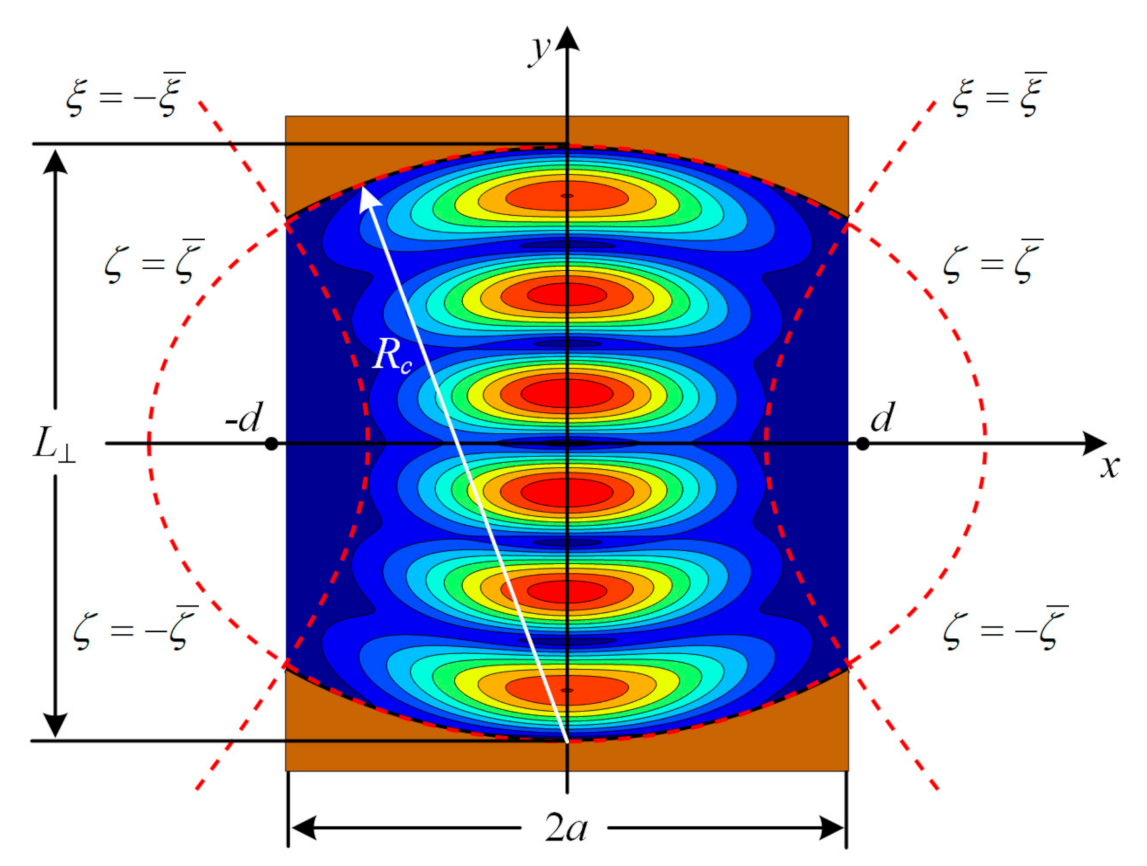
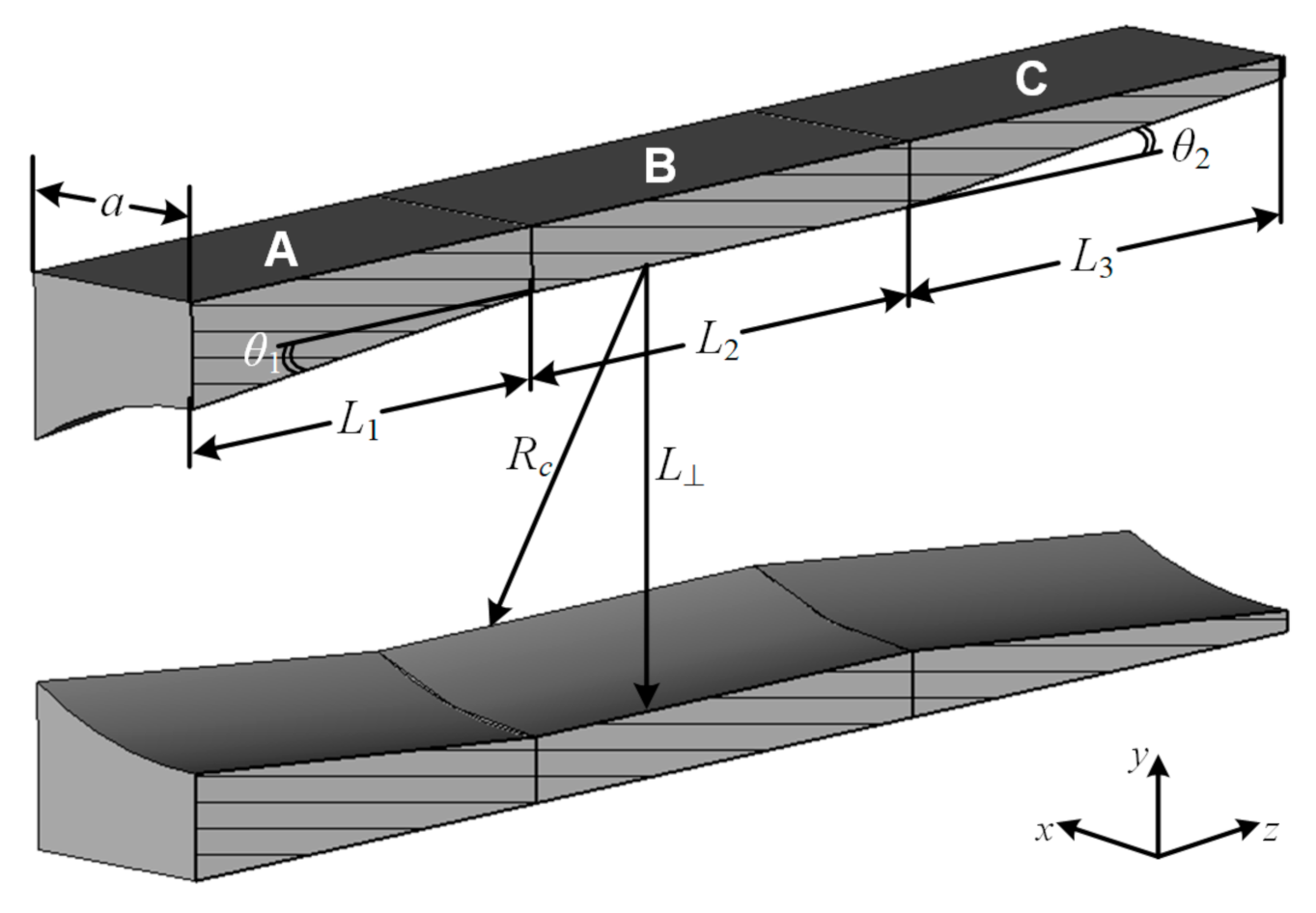
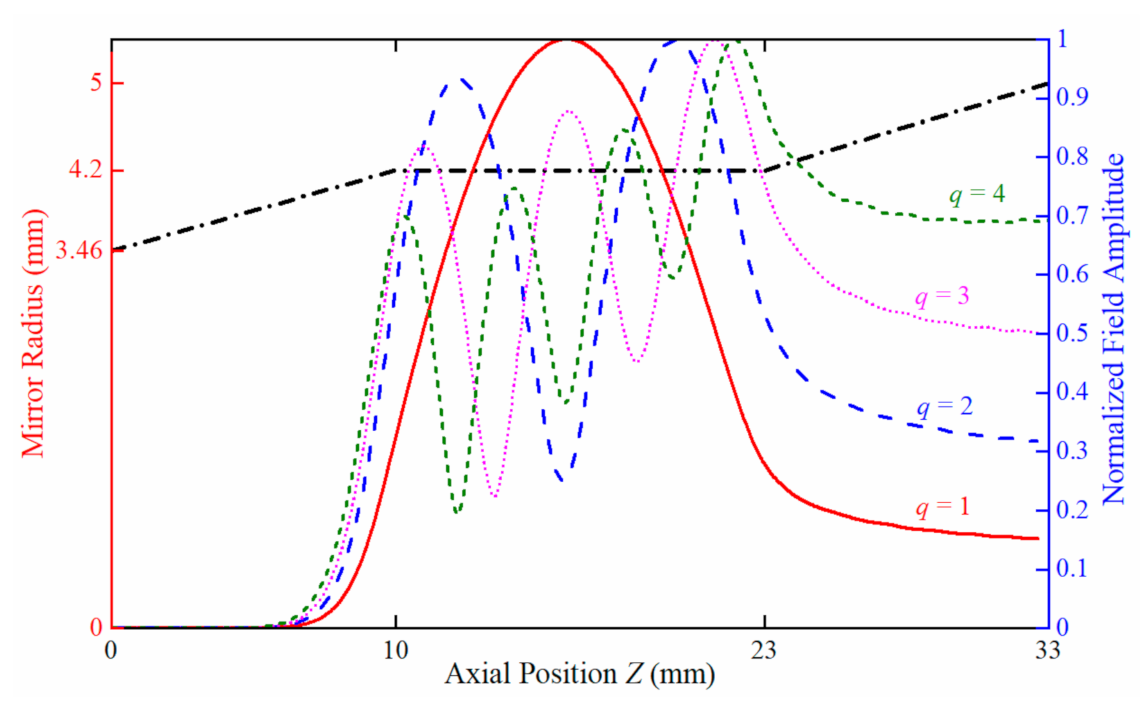
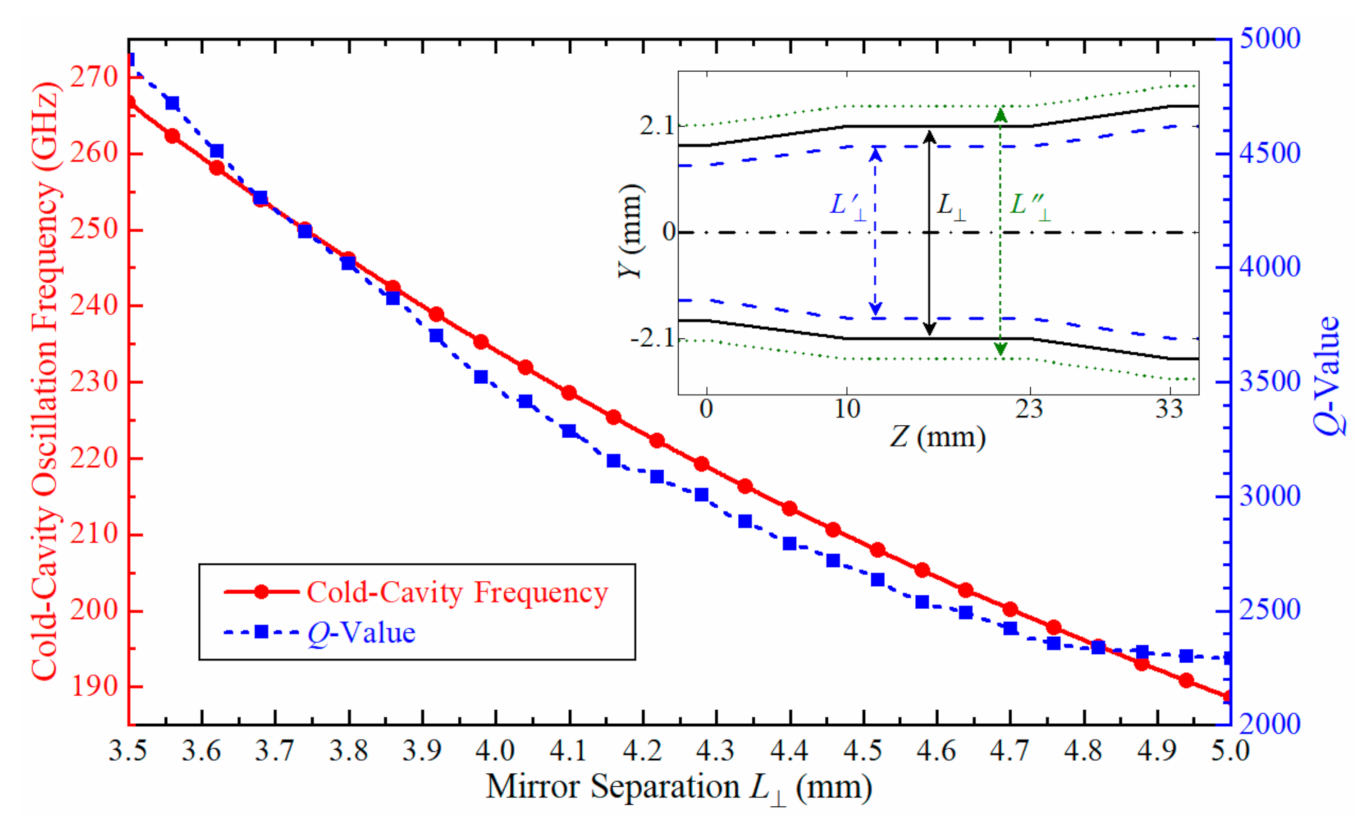
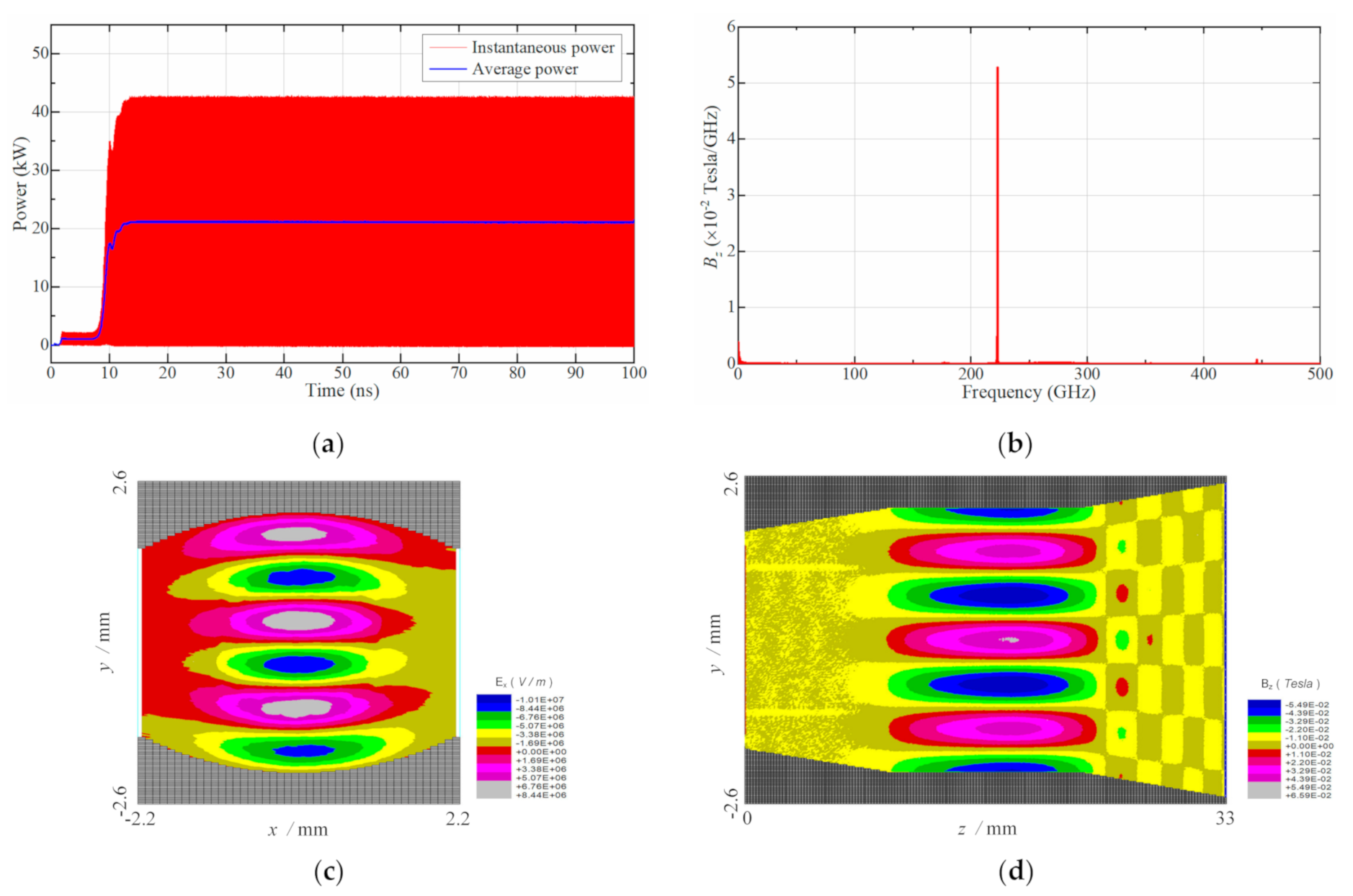



| Rc | L⊥ | a | L1 | L2 | L3 | θ1 | θ2 |
|---|---|---|---|---|---|---|---|
| 4.20 mm | 4.20 mm 1 | 2.2 mm | 10 mm | 13 mm | 10 mm | 2.12° | 2.29° |
| q | Frequency f (GHz) | Q | f − f/Q (GHz) | f + f/Q (GHz) |
|---|---|---|---|---|
| 1 | 223.27 | 3087 | 223.198 | 223.342 |
| 2 | 223.91 | 779 | 223.623 | 224.197 |
| 3 | 224.98 | 350 | 224.337 | 225.623 |
| 4 | 226.44 | 208 | 225.351 | 227.529 |
| Beam Voltage V0 | Magnetic Field B0 | Beam Current Ib | Pitch Factor α | Beam Radius Rb |
|---|---|---|---|---|
| 40 kV | 8.40 T | 5 A | 1.1 | 1.09 mm |
Publisher’s Note: MDPI stays neutral with regard to jurisdictional claims in published maps and institutional affiliations. |
© 2021 by the authors. Licensee MDPI, Basel, Switzerland. This article is an open access article distributed under the terms and conditions of the Creative Commons Attribution (CC BY) license (http://creativecommons.org/licenses/by/4.0/).
Share and Cite
Guan, X.; Zhang, J.; Fu, W.; Lu, D.; Yang, T.; Yan, Y.; Yuan, X. Frequency Tuning Characteristics of a High-Power Sub-THz Gyrotron with Quasi-Optical Cavity. Electronics 2021, 10, 526. https://doi.org/10.3390/electronics10050526
Guan X, Zhang J, Fu W, Lu D, Yang T, Yan Y, Yuan X. Frequency Tuning Characteristics of a High-Power Sub-THz Gyrotron with Quasi-Optical Cavity. Electronics. 2021; 10(5):526. https://doi.org/10.3390/electronics10050526
Chicago/Turabian StyleGuan, Xiaotong, Jiayi Zhang, Wenjie Fu, Dun Lu, Tongbin Yang, Yang Yan, and Xuesong Yuan. 2021. "Frequency Tuning Characteristics of a High-Power Sub-THz Gyrotron with Quasi-Optical Cavity" Electronics 10, no. 5: 526. https://doi.org/10.3390/electronics10050526
APA StyleGuan, X., Zhang, J., Fu, W., Lu, D., Yang, T., Yan, Y., & Yuan, X. (2021). Frequency Tuning Characteristics of a High-Power Sub-THz Gyrotron with Quasi-Optical Cavity. Electronics, 10(5), 526. https://doi.org/10.3390/electronics10050526






